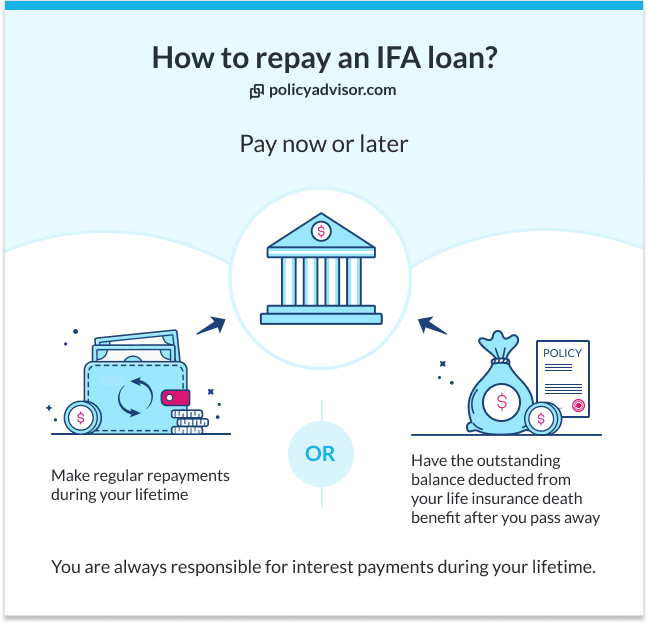- The process to get an IFA starts by assessing your needs and buying a whole life insurance policy
- You should be diligent and assess your needs to map out your strategy before you get started
- Access to financing is immediate, but the length of the process can depend on your lender
You can set up an immediate financing arrangement as a strategic way to tackle your financial goals. But, the whole thing can seem daunting if you’re not sure how to go about it.
If you’ve done your preliminary research and you’re ready to explore if an IFA is right for you, read this article to find out how to get started, what you will need, and what to expect.
How to set up an immediate financing arrangement?
To start an immediate financing arrangement, follow these steps:
Before you really get the ball rolling, you should think about your future goals and map out a financial plan in collaboration with your life insurance advisor.
An experienced licensed insurance advisor can work alongside your accountant and provide invaluable guidance in navigating the financial implications of an IFA effectively. To begin this process, it’s crucial to assess key factors such as:
- Determining the amount of life insurance you need to cover future estate and tax planning needs
- Estimating the cost of the life insurance premiums
- Deciding how to own and pay for the life insurance policy—personally or through a corporation
- Identifying the amount of financing required and its intended use
- Planning for interest payments and ensuring affordability
- Research different lenders offering IFAs, considering factors such as loan terms, lending amount thresholds, collateral requirements, financing costs, flexibility with early payments, etc
At this stage, you should also do due diligence research. Our website has tons of resources covering topics like what is an IFA, how does it work, and more that you can use to make sure you’re ready.
For an IFA, you will need a whole life insurance policy (or a universal life insurance policy) with a suitable death benefit and cash value. Here’s what you should do:
- Contact a life insurance advisor at PolicyAdvisor to find the whole life policy that works best for the immediate financing strategy you want to set up
- If you intend to set up an IFA, you would typically need to optimize for high early cash values in your policy. Our advisors will run various structures for you to set up a policy structure that meets your cash value and projected death benefit needs
- Have the advisor review the life insurance illustration with you — this will show you the expected cash value growth and expected internal rates of return on the policy
- The advisor will also set up an IFA illustration that you will need to show the bank to apply for your IFA
- Structure the whole life insurance appropriately as a business owner or as an individual owner
- Apply for a whole life insurance policy that is appropriate for your needs
- If you are getting the IFA as a business, put the policy in the business’ name or in the name of a key person such as the business owner or a key shareholder
- Put the beneficiary as your estate, your loved ones, your business, or whoever you need to get the insurance policy death benefit payout after you pass away
- Opt for annual premium payments and pay the full amount for the year as soon as you buy your policy
- Get your policy documents, including the policy itself and insurance illustration, and store them in a safe place
Once you have the insurance part of it sorted out, you should:
- Choose the Canadian bank, lender, or financial institution you want to borrow from
- Find out their requirements for an IFA. They may ask for:
- A minimum loan amount
- An insurance policy from only an approved life insurance company
- Proof of strong cash flow
- Call, set up an appointment, or visit in person to apply for immediate financing in the form of a line of credit. Alternatively, let our advisors at PolicyAdvisor manage the process seamlessly for you
- Apply for up to 100% of the cost of life insurance premiums you paid in Step 1, or up to 100% of the projected cash surrender value in your insurance illustration
When you apply for the line of credit, tell your lender that you want to use your whole life insurance policy as collateral. Here’s how this works:
- You and your lender agree on collateral assignment of life insurance. This just means that you agree your life insurance policy will be used by the lender, in case you are unable to pay back the loan proceeds
- You don’t change the beneficiary — whoever you named as the beneficiary in Step 2 will stay the same
- Your lender lets your insurance provider know that the policy has been assigned as collateral, but it’s just for FYI purposes — the insurance company won’t be named in the credit facility agreement
Experienced teams of advisors are already familiar with IFAs so you may not need to do much explaining once you tell them you want an IFA in step 3.
The next step is to wait for the lender to process your application. This can go a few ways:
- The lender will let you know when they approve your application. This can be immediate or take a few days, depending on the lender
- The lender can ask for additional collateral if they need extra security, depending on how much you are borrowing. They will contact you to ask what other assets you can use as collateral, such as real estate or investments
- Both you and your lender agree on loan terms, including:
- Interest payment amounts
- Interest rate
- Repayment terms
- Repayment schedule
- And more
After your application is completed and the terms have been mutually agreed to, you can get instant access to the financing.
You can do anything with the loan proceeds you receive. In Canada, most people use it to reinvest in high-return ventures. There are key reasons for this:
- To cover interest & preserve capital
With an IFA, you are responsible for interest payments. The most strategic way to use an IFA loan is to use the financing you get to cover those payments. You can invest that money into an income-generating business to cover interest, so you don’t have to incur interest expense as an out-of-pocket cost. - For tax benefits
There can be tax implications for immediate financing. But, this is avoided if you use the money to reinvest in a business that generates income. An IFA is not taxed as long as you use the credit for investment purposes or similar economic activities.
Now that the agreement has been made and you have the loan proceeds, you have to live up to your part of the arrangement. This varies depending on the agreement you have with your bank or lender. You must:
- Pay the interest monthly
- Make loan drawdowns according to the schedule you agreed to
- Pay off the loan according to the schedule you agreed to
Remember, the lender is holding your life insurance policy as collateral — and they may be holding other types of collateral too. If you fail to follow the terms, they can take ownership of your collateral or deduct from your life insurance cash value or death benefit.
If you have a line of credit that has to be revisited every year, your lender might want to check on:
- Policy performance — how well your insurance policy is doing, if it’s still active, if it’s building cash value as planned, etc.
- Loan repayment status — if you’ve been making interest payments and keeping up with the schedule as agreed to
- Additional collateral security requirements — if they need you to provide any more collateral to keep the line of credit
- Your financial health — to confirm that you have sufficient income to keep up with payments
They may also revisit annual renewal fees to determine if they will stay the same or not.
Do I need to do anything else to set up an IFA?
Yes, while the 8 steps covered above are standard, you may have additional steps to take. But these steps are optional and can vary, depending on the agreement you have with your lender. It may be different for everyone, so not everyone who gets an IFA may have to take the steps below.
Repaying the loan during your lifetime
If you choose to pay the loan off early, you can make regular loan payments the same way as you would with any loan or financing arrangement.
You would pay regular interest payments, plus pay back the amount you borrowed as annual deposits into the IFA account or as a lump sum at any point of time. If you go with this option, your beneficiaries get the full policy proceeds from your life insurance after you pass away.
Repaying the loan after your death
If you don’t want to worry about paying back the IFA right away, you can also let it be paid back as a deduction from your death benefit.
You still have to make interest payments during your lifetime. But, once you pass away, any outstanding loan balance would be deducted from your insurance policy’s tax-free death benefit. Keep in mind that this will mean less money for your beneficiaries, though.
How long does an IFA take to process?
The processing time for an IFA application depends on the lender. Usually IFA applications are approved within 1 to 3 weeks.
Once you’re approved, financing comes through right away. There’s no waiting period — that’s why it’s called immediate financing, after all.
Contact a professional
If you’re interested in starting an IFA, you should speak to an expert to make sure you have your ducks lined up in a row. An IFA strategy can have many benefits for business owners and other high-income earners in Canada. But you don’t have to decide alone.
Schedule some time with one of our insurance professionals and we’ll be happy to help you figure out if an IFA could be right for you.
FAQs about how to set up an immediate financing arrangement
Yes, banks and lenders typically charge a flat fee for an immediate financing arrangement. This is separate from interest payments. The flat fee is typically about $500 to set up the IFA.
Depending on the loan amount, the initial fee may be waived by the lender. Ask what the charges will be before you decide who to go with it.
Your only insurance options for an IFA are:
- A participating permanent life insurance policy
- Cash value universal life insurance, but that comes with more risks and complications
Getting an immediate financing arrangement (IFA) starts by looking at your financial goals and buying a whole life insurance policy. From there, you go to the bank or lender of your choice and apply for a line of credit using your policy as collateral. You will need to ensure you have the necessary documentation and that you know what to expect.







